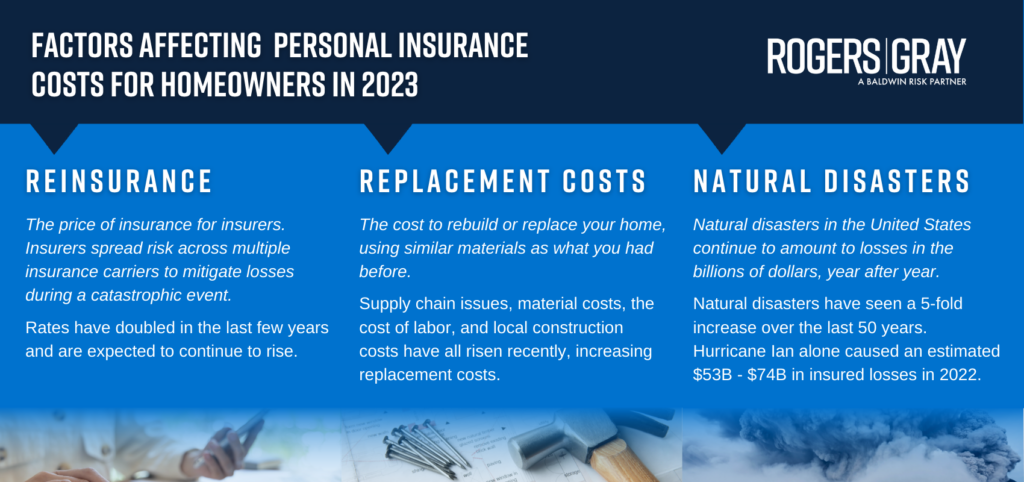Trust has always been a critical element of how we conduct business at RogersGray.
With this in mind, we feel it’s important to share information related to what is causing the current disruption in the property insurance marketplace, understand the factors that will likely affect insurance rates in 2023, and share steps to mitigate that at your next renewal.

The insurance industry is currently entering what is known as a “hard market”. A hard market occurs when carriers reduce their risk exposure and choose not to write insurance in certain areas, resulting in more expensive and harder to find insurance options.
This is an industry wide issue with the personal property market being impacted by skyrocketing increases for claims and associated costs including inflation, supply chain issues, and severity of weather-related events. There were 20 separate $1 billion + loss events from weather in 2021 alone.
Your team of insurance professionals at RogersGray are leveraging our size and scale to stay on top of changes, find alternative options, and are working with clients to discuss their options to lessen personal impact.
REINSURANCE
Also known as insurance for insurers.
Reinsurance is the practice whereby insurers transfer portions of their risk portfolios to other parties to reduce the likelihood of paying a large obligation resulting from large claims volume. Reinsurance gives the insurer more security by increasing its ability to withstand the financial burden when unusual and major events occur.
A good example of this is a natural disaster like Hurricane Ian. No insurance carrier could shoulder the total cost to rebuild from a storm like that. Reinsurance protects the insured by making sure the insurance carrier remains financially solvent. Most reinsurance companies are reporting that US results for the last 5 out of 6 years have been poor. With this, reinsurance rates have more than doubled in the last couple of years and we’re seeing data showing that reinsurance rates will continue to increase 25-40% in 2023. One carrier we work with just experienced a 64% increase.
These increases result in a greater cost to the carrier to insure their policies.
REPLACEMENT COSTS
Home insurance is based on the cost to rebuild and replace your home, not its market value.
While market value is the amount your home is worth on the housing market, your home insurance coverage limit is based on the estimated cost to rebuild your home: the cost to repair, rebuild or replace what you had before, using materials of similar type and quality.
Factors affecting rising replacement costs:
- Supply chain disruptions of home materials
- Rising material costs
- Labor supply and demand
- Local Construction Costs

NATURAL DISASTERS
The 2022 catastrophe season, with an estimated $53B – $74B in insured losses from Hurricane Ian alone, is poised to deal a far-reaching blow to a shaky property insurance market already facing multiple pressures.
Over the past 50 years, extreme weather events or climate disasters have seen a 5-fold increase with no end in sight.
Read More: https://www.newsweek.com/climate-change-costs-americans-insurance-rates-headed-spike-1741133
OPTIONS TO REVIEW FOR HOMEOWNERS
There are a few steps you can take to potentially lower costs.
Increasing Deductibles Package Your Policies
Combine Home/Auto/Umbrella
Adjust Your Coverage Limits
Reduce or eliminate billing fees – go on EFT or pay in full
Apply All Eligible Discounts:
– Central Station Alarm
– Property Improvement
– Smart Water Leak Detector
STILL HAVE QUESTIONS?
Janet Kliment, CISR Elite
Director of Client Experience

 Janet is a Director of Client Experience at RogersGray. As a Director of Client Experience, Janet oversees a team of more than 80 dedicated personnel in both sales and service. Janet resides on Cape Cod with her husband. You can connect with Janet on
Janet is a Director of Client Experience at RogersGray. As a Director of Client Experience, Janet oversees a team of more than 80 dedicated personnel in both sales and service. Janet resides on Cape Cod with her husband. You can connect with Janet on